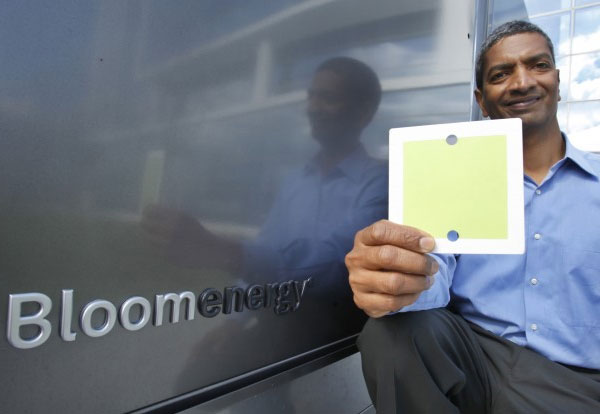 Bloom Energy shook the cleantech sector earlier this year when it unveiled its unique Bloom Box, a fuel cell capable of powering 100 homes while producing close to zero greenhouse-gas emissions. Now, despite the company’s assurances that it is closing in on an IPO next year, it looks like it might be raising $50 million more to get it there.
Bloom Energy shook the cleantech sector earlier this year when it unveiled its unique Bloom Box, a fuel cell capable of powering 100 homes while producing close to zero greenhouse-gas emissions. Now, despite the company’s assurances that it is closing in on an IPO next year, it looks like it might be raising $50 million more to get it there.
The company has declined to comment on the story. Private Equity Hub caught wind of the fundraising via internal sources, who also said that Northgate Capital may be joining existing backers Kleiner Perkins Caufield & Byers and New Enterprise Associates. These investors have already sunk $400 million into Bloom, which is quickly becoming one of the most expensive green tech plays to date.
Despite the media blitz in February, a lot of mystery still surrounds the Bloom Box. Right now, it is sold only on a large scale, with units costing $800,000 apiece. Installations are already pumping out power for early adopters like Wal-Mart, Google and FedEx. eBay reported that its nine Bloom Boxes saved it $100,000 in energy costs over the first nine months they were installed.
This sounds all well and good, but the technology — initially developed by now CEO KR Sridhar at NASA — is still secretive, and its implications sound too radical to be true. Bloom says that in the next 5 to 10 years it will be selling fuel-cell boxes for individual households for less than $3,000. If this happens, the company could remove whole homes from the grid, supplanting utilities and their unwieldy, long-distance transmission lines. This would restructure the way energy is delivered the world over.
There is a camp of analysts and investors — like Kleiner’s John Doerr, a serious evangelist — that believes Bloom has the same game-changing potential as Google or Facebook, the first of its kind in the cleantech sector. But others wonder how the company will even afford to get its products to market if it’s already burnt through so much money and is now looking for more.
As is, there’s no way Bloom is going to compete cost-wise with utility-delivered energy for next five years at least. In order to encourage adoption, the government would have to launch a major consumer incentive campaign. But this is unlikely to happen, considering how powerful utility interests are in the U.S. It’s been suggested that utilities might become Bloom’s biggest customers, installing the boxes in their coverage areas and selling the energy they generate. But utilities aren’t going to want to do this until they absolutely have to.
Private Equity Hub has also heard that Bloom told investors that its last round of funding would provide enough runway to get it to its public exit. There’s a sense that the company doesn’t have a good grasp on its roadmap, and is trying to run on the same hype surrounding other cleantech stars like Tesla Motors.
This makes participating in Bloom’s rumored new round a hefty bet for new investors. Do they sit it out and hang their heads if and when the technology revolutionizes the global energy market? Or do they buy a stake and wait for years as the Bloom Box struggles to break into the mainstream? Both outcomes are equally likely at this juncture.
We will update the story as soon as we hear back from analysts and prospective investors.
VentureBeat's mission is to be a digital town square for technical decision-makers to gain knowledge about transformative enterprise technology and transact. Learn More
